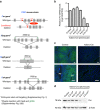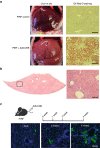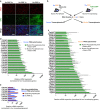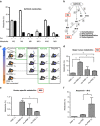A novel humanized mouse lacking murine P450 oxidoreductase for studying human drug metabolism
- PMID: 28659616
- PMCID: PMC5489481
- DOI: 10.1038/s41467-017-00049-x
A novel humanized mouse lacking murine P450 oxidoreductase for studying human drug metabolism
Erratum in
-
Erratum: A novel humanized mouse lacking murine p450 oxidoreductase for studying human drug metabolism.Nat Commun. 2017 Oct 17;8(1):984. doi: 10.1038/s41467-017-01314-9. Nat Commun. 2017. PMID: 29042563 Free PMC article.
Abstract
Only one out of 10 drugs in development passes clinical trials. Many fail because experimental animal models poorly predict human xenobiotic metabolism. Human liver chimeric mice are a step forward in this regard, as the human hepatocytes in chimeric livers generate human metabolites, but the remaining murine hepatocytes contain an expanded set of P450 cytochromes that form the major class of drug-metabolizing enzymes. We therefore generated a conditional knock-out of the NADPH-P450 oxidoreductase (Por) gene combined with Il2rg - /- /Rag2 - /- /Fah - /- (PIRF) mice. Here we show that homozygous PIRF mouse livers are readily repopulated with human hepatocytes, and when the murine Por gene is deleted (<5%), they predominantly use human cytochrome metabolism. When given the anticancer drug gefitinib or the retroviral drug atazanavir, the Por-deleted humanized PIRF mice develop higher levels of the major human metabolites than current models. Humanized, murine Por-deficient PIRF mice can thus predict human drug metabolism and should be useful for preclinical drug development.Human liver chimeric mice are increasingly used for drug testing in preclinical development, but express residual murine p450 cytochromes. Here the authors generate mice lacking the Por gene in the liver, and show that human cytochrome metabolism is used following repopulation with human hepatocytes.
Conflict of interest statement
The authors declare no competing financial interests.
Figures




Similar articles
-
Humanized liver TK-NOG mice with functional deletion of hepatic murine cytochrome P450s as a model for studying human drug metabolism.Sci Rep. 2022 Sep 1;12(1):14907. doi: 10.1038/s41598-022-19242-0. Sci Rep. 2022. PMID: 36050438 Free PMC article.
-
Chimeric mice with humanized liver.Toxicology. 2008 Apr 3;246(1):9-17. doi: 10.1016/j.tox.2007.11.012. Epub 2007 Nov 22. Toxicology. 2008. PMID: 18248870 Review.
-
Expression of human cytochromes P450 in chimeric mice with humanized liver.Drug Metab Dispos. 2004 Dec;32(12):1402-10. doi: 10.1124/dmd.104.001347. Epub 2004 Sep 21. Drug Metab Dispos. 2004. PMID: 15383493
-
Role of hepatic cytochromes P450 in bioactivation of the anticancer drug ellipticine: studies with the hepatic NADPH:cytochrome P450 reductase null mouse.Toxicol Appl Pharmacol. 2008 Feb 1;226(3):318-27. doi: 10.1016/j.taap.2007.09.017. Epub 2007 Sep 26. Toxicol Appl Pharmacol. 2008. PMID: 17976674
-
Current status of prediction of drug disposition and toxicity in humans using chimeric mice with humanized liver.Xenobiotica. 2014 Jan;44(2):123-34. doi: 10.3109/00498254.2013.868062. Epub 2013 Dec 13. Xenobiotica. 2014. PMID: 24329499 Review.
Cited by
-
Small Animal Models for Human Immunodeficiency Virus (HIV), Hepatitis B, and Tuberculosis: Proceedings of an NIAID Workshop.Curr HIV Res. 2020;18(1):19-28. doi: 10.2174/1570162X18666191223114019. Curr HIV Res. 2020. PMID: 31870268 Free PMC article.
-
Humanized liver TK-NOG mice with functional deletion of hepatic murine cytochrome P450s as a model for studying human drug metabolism.Sci Rep. 2022 Sep 1;12(1):14907. doi: 10.1038/s41598-022-19242-0. Sci Rep. 2022. PMID: 36050438 Free PMC article.
-
Animal models to study bile acid metabolism.Biochim Biophys Acta Mol Basis Dis. 2019 May 1;1865(5):895-911. doi: 10.1016/j.bbadis.2018.05.011. Epub 2018 May 18. Biochim Biophys Acta Mol Basis Dis. 2019. PMID: 29782919 Free PMC article. Review.
-
Cytochrome P450-Based Drug-Drug Interactions of Vonoprazan In Vitro and In Vivo.Front Pharmacol. 2020 Feb 14;11:53. doi: 10.3389/fphar.2020.00053. eCollection 2020. Front Pharmacol. 2020. PMID: 32116727 Free PMC article.
-
Advancements in stem cell-derived hepatocyte-like cell models for hepatotoxicity testing.Stem Cell Res Ther. 2021 Jan 25;12(1):84. doi: 10.1186/s13287-021-02152-9. Stem Cell Res Ther. 2021. PMID: 33494782 Free PMC article. Review.
References
-
- Nelson DR, Zeldin DC, Hoffman SM, Maltais LJ, Wain HM, Nebert DW. Comparison of cytochrome P450 (CYP) genes from the mouse and human genomes, including nomenclature recommendations for genes, pseudogenes and alternative-splice variants. Pharmacogenetics. 2004;14:1–18. doi: 10.1097/00008571-200401000-00001. - DOI - PubMed
Publication types
MeSH terms
Substances
Grants and funding
LinkOut - more resources
Full Text Sources
Other Literature Sources
Molecular Biology Databases
Research Materials
Miscellaneous

